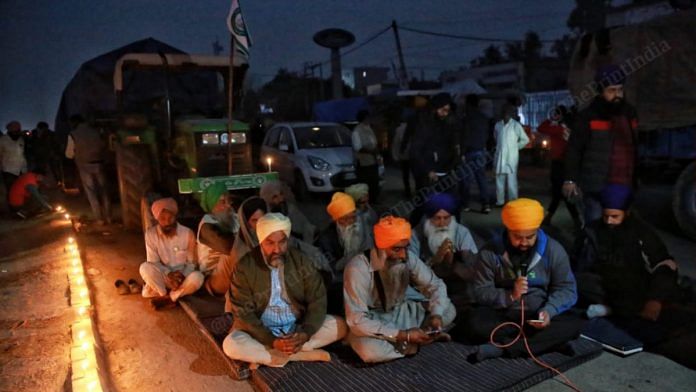As the New Year begins, a cold wave has gripped North India. A slew of headlines about the dropping temperatures has connected 2020 and 2021. ‘Delhi records 1.1°C’, ‘Don’t drink alcohol, get indoors: IMD’, ‘Srinagar freezes at -5.9°C’, and ‘Farmers vow to carry on protests despite cold, deaths’.
Baby, it’s cold outside. The song has become somewhat controversial to recall in the post-MeToo age. But as teeth chatter across north India, this could be the song on everyone’s lips.
And, if that wasn’t bad, there is prediction of rain in the next few days in and around the national capital. Yes, vacationers have seen (and played with) snow this week in hill stations like Kasauli, Shimla, Kufri, and Dharamshala. But the cold temperatures haven’t brought joy to all. Some crops will suffer, farmers protesting at Delhi’s borders and those living on the streets are bracing for the worst, and the frigid temperatures haven’t eased anything in Ladakh.
And that’s why the cold wave this winter is ThePrint’s Newsmaker of the Week.
Also read: Thin blankets & no masks — How Delhi night shelters are coping in a freezing Covid winter
What is a cold wave?
To understand the chilly winds, rains and shivering temperature in North India, we must look at a change happening far away in the waters of the Pacific Ocean.
La Niña (Little Girl) is a weather phenomenon and denotes the cold phase of the El Niño-Southern Oscillation (ENSO) cycle. It pushes warm waters westwards, leaving cold waters and winds to rise up in the Eastern Pacific. La Niña has global climate implications. A change in ocean temperatures has a ripple on weather everywhere. It brings waves of cold and rains to India and causes droughts in South America. In October, the India Meteorological Department (IMD) head Mrutyunjay Mohapatra had predicted a ‘colder-than-usual’ winter.
According to the IMD, a cold wave means minimum temperatures below 10°C in the plains, and 4.5°C lesser than the season’s normal for two consecutive days. Regions like Haryana, Delhi, Punjab, and Himachal Pradesh have the ‘western disturbances’ – which originate in the Mediterranean and impact the winds in the upper regions of the Himalayas – to blame for the current dip in temperatures.
From 2 January onwards, the minimum temperature is supposed to rise, with light rain and another ‘intense’ cold wave expected to hit from 7 January. There are also forecasts of ground frost and intense fog in the region. And in case you forgot about air pollution, that’s there too in Delhi (in the ‘very poor’ category).
Stronger La Niñas are just a part of why winter is this unusually cold. The larger reason is us. Human-made climate change had led to 2020 being a year of extremes — wildfires, droughts, extreme colds, unseasonal rain, and swarms of locusts destroying crops.
Also read: Library, ‘blanket langar’ & even a salon — farmers have made Singhu border a mini ‘pind’
Don’t drink and shiver
The IMD issued another advisory a few days ago. It even asked people of the northern states to avoid drinking alcohol (dashing the thrills of tens of thousands of Old Monkers wrapped in blankets). New Year’s week may be the time to drink and merry, but consumption of alcohol actually drops your body temperature (no matter how warm and giddy you feel at first) and causes dehydration. Worse, drinking and going outdoors in such cold can cause hypothermia too.
The IMD advisory also said that shivering is the first sign your body is losing heat. Wear layers of clothes, moisturise, eat Vitamin-C rich foods, and get indoors.
In Siberia’s Yakutsk city, the coldest place to live on earth, residents can barely stay outside for more than a few minutes. Their trick? Plan your outings carefully and let the cold decide for you.
Also read: A young Dutch designer is helping the homeless stay warm, one sleeping-bag coat at a time
Winter of discontent
If 2020 started with women resolutely sitting in Delhi’s Shaheen Bagh in the cold, 2021 has taken off with farmers refusing to budge, no matter what the Met Department predicts.
From farmers heating themselves against tiny fires on the road to the Army settling in for a long winter along the Line of Actual Control, Indians are all but hibernating. And social distancing in the times of Covid is not a luxury the homeless can afford when staying in temporary government-run shelters.
Tea, hot langar food, desi heaters, and medicines for the farmers. Coffee, limited gas heaters, and medicines for the police personnel in the area.
Up north from the protests, the armed forces have dug in against the Chinese People’s Liberation Army (PLA) — with special clothing, kerosene, specialised tents, and ramped-up medical facilities. Lt Gen. H.S. Panag (retd) wrote that the temperature of -35°C makes the soldier much less efficient. It was the long hard winter at the LAC that every military expert warned us about last year.
The cold wave will be over in a few days, but winter is a season that only those who are sufficiently warm can enjoy. It is not a season for all. It is a season that makes us think about income inequality much more than ever. The good samaritans are donating blankets, building boxes for street dogs, and sharing a cup of hot tea with those who need it. Breaking the ice.
Views are personal.




What is this meaningless nonsensical article trying to convey?